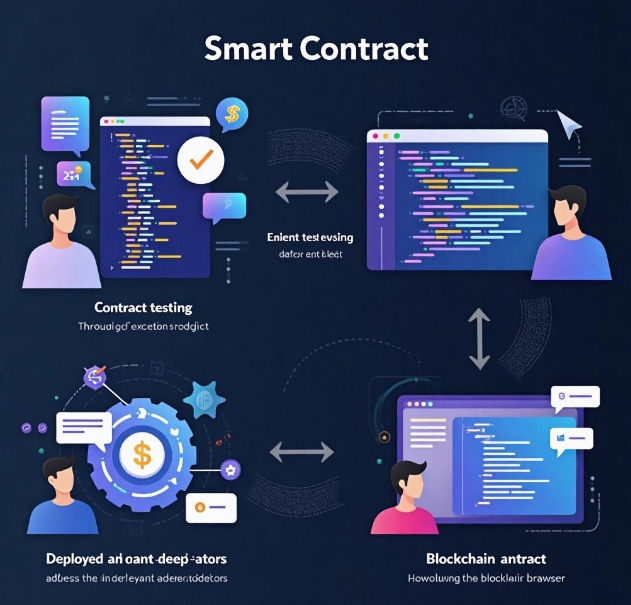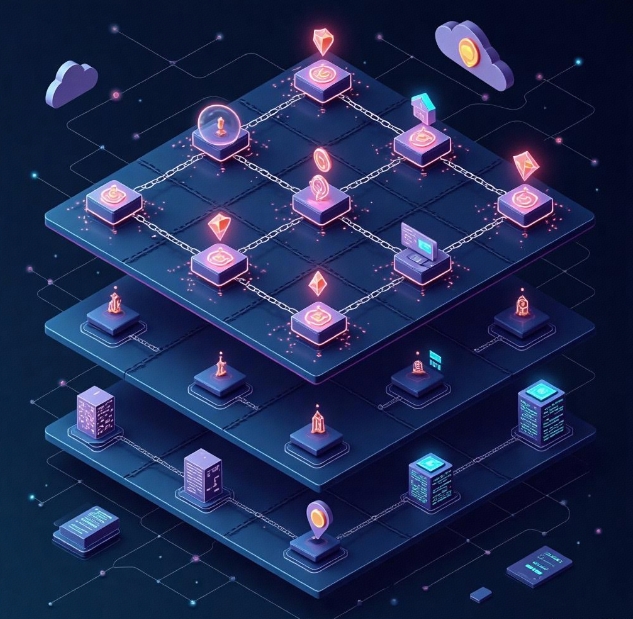Overview of DApp Development: How to Build a Decentralized Application?
- latest articles
- 1.DApp Development & Customization: Merging Diverse Market Needs with User Experience 2.Analysis of the Core Technical System in DApp Project Development 3.How to achieve cross-chain interoperability in Web3 projects? 4.How does the tokenization of points reconstruct the e-commerce ecosystem? 5.How to Set and Track Data Metrics for a Points Mall? 6.What is DApp Development? Core Concepts and Technical Analysis 7.Inventory of commonly used Web3 development tools and usage tips 8.Development of a Distribution System Integrated with Social E-commerce 9.Six Key Steps for Businesses to Build a Points Mall System 10.What is DApp Development? A Comprehensive Guide from Concept to Implementation
- Popular Articles
- 1.Future Trends and Technology Predictions for APP Development in 2025 2.Analysis of the DeFi Ecosystem: How Developers Can Participate in Decentralized Finance Innovation 3.From Zero to One: How PI Mall Revolutionizes the Traditional E-commerce Model 4.DAPP Development | Best Practices for Professional Customization and Rapid Launch 5.Recommended by the Web3 developer community: the most noteworthy forums and resources 6.From Cloud Computing to Computing Power Leasing: Building a Flexible and Scalable Computing Resource Platform 7.How to Develop a Successful Douyin Mini Program: Technical Architecture and Best Practices 8.Shared Bike System APP: The Convenient Choice in the Era of Smart Travel 9.How to Create a Successful Dating App: From Needs Analysis to User Experience Design 10.From Design to Development: The Complete Process of Bringing an APP Idea to Life
With the rise of blockchain technology, decentralized applications (DApps) have become a hot topic in the technical field. DApps, or decentralized applications, are applications that run on a blockchain and do not rely on traditional centralized servers. Unlike traditional applications, the core advantage of DApps lies in their decentralized nature, which means the management and control of the application are no longer concentrated in a single entity but are distributed across multiple nodes in the network through blockchain's smart contract technology. This approach not only ensures the security and transparency of the system but also grants users greater privacy protection and control.
In this article, we will delve into the concept of DApps, how they work, and how to build a decentralized application. We hope that through this article, readers will gain a comprehensive understanding of DApps and master the basic steps to build one.
What is a DApp?
A DApp, or decentralized application, is an application built using blockchain technology. Its most significant feature is the absence of a single administrator or controller; instead, it relies on the nodes of the blockchain network for management and operation. Traditional applications often depend on a centralized server to store and process data, whereas DApps achieve decentralization through smart contracts and distributed ledgers.
Characteristics of DApps:
Decentralization: DApps operate without relying on any centralized server or entity, instead functioning based on a cluster of blockchain nodes. All data storage and computational tasks are distributed across the blockchain network, allowing anyone to participate.
Open Source Code: The source code of DApps is typically open source, meaning anyone can view, modify, and use it. This transparency helps DApps gain higher trust.
Use of Smart Contracts: DApps usually rely on smart contracts to implement application logic. Smart contracts are automated protocols that execute within the blockchain network and ensure the enforcement of rules.
Incentive Mechanisms: Many DApps use token economies to incentivize user participation in the network, which not only enhances the activity of the DApp but also encourages participants to engage in behaviors beneficial to the platform.
Immutability: DApps based on blockchain possess immutability; once data is written to the blockchain, no one can alter it. This ensures the transparency of the application and the security of the data.
Application Scenarios of DApps
The decentralized nature of DApps gives them broad application potential in various fields, especially in the following areas:
Financial Sector (DeFi): Decentralized Finance (DeFi) is one of the most important applications of DApps. Through decentralized exchanges (DEX), lending platforms, stablecoins, etc., DeFi applications allow users to conduct transactions, loans, and storage without relying on traditional financial institutions.
NFT Market: Decentralized applications provide a decentralized platform for the creation and trading of digital assets. NFTs (Non-Fungible Tokens) are digital assets realized through blockchain technology. Decentralized NFT markets enable users to truly own and trade these digital works.
Supply Chain Management: DApps can help companies achieve transparency and traceability in supply chain management. By recording every operation in the supply chain on the blockchain, the immutability and authenticity of data are ensured, enhancing the efficiency and security of the supply chain.
Social Platforms: Decentralized social platforms are gradually emerging, allowing users to freely express and communicate without worrying about data leaks or unilateral control by a company.
Gaming Applications: Decentralized games (also known as blockchain games) use blockchain technology to enable players to truly own in-game items, such as props and characters. These items can circulate between different games and even be converted into real value.
How to Build a DApp?
Building a DApp is not an easy task; it involves multiple technical aspects, including blockchain, smart contracts, front-end development, and more. Here are some key steps to build a DApp:
1. Choose a Suitable Blockchain Platform
Before building a DApp, the first step is to choose a suitable blockchain platform. Currently, the most popular DApp development platform is Ethereum, which supports smart contracts and has a large developer community. Besides Ethereum, other blockchain platforms like Binance Smart Chain, Solana, and Polkadot can also be used for DApp development. Different platforms have different characteristics, and developers need to choose the most suitable one based on their requirements.
2. Develop Smart Contracts
Smart contracts are the core of a DApp; they determine the application's logic and rules. Smart contracts are typically written in programming languages, such as Solidity, commonly used on Ethereum. Once deployed to the blockchain, smart contracts automatically execute according to predefined rules without human intervention.
The development process of smart contracts usually includes the following steps:
Requirements Analysis: Determine the functions and rules of the smart contract, such as token issuance, transaction rules, etc.
Write the Smart Contract: Use programming languages like Solidity to write the smart contract code.
Test the Smart Contract: Deploy and test on a test network to ensure the smart contract has no vulnerabilities and works as expected.
Deploy the Smart Contract: Deploy the smart contract to the blockchain to start formal operation.
3. Develop the Front-End Interface
A DApp is not just about smart contracts; it also requires a front-end interface for users to interact with. Front-end development typically uses traditional web technologies (such as HTML, CSS, JavaScript) for construction, but the front-end of a DApp differs from traditional applications as it needs to interact with the blockchain network.
To achieve this, developers usually use JavaScript libraries like Web3.js or Ethers.js, which help the front-end communicate with the blockchain, such as calling smart contracts, reading blockchain data, etc.
Common front-end development steps include:
Design the User Interface: Create an intuitive and user-friendly interface so that users can easily interact with the DApp.
Integrate Web3.js or Ethers.js: These libraries can interact with Ethereum or other blockchain platforms, enabling the front-end to initiate transactions, query blockchain data, etc.
Handle Wallet Connection: DApps usually require users to connect to a blockchain wallet (such as MetaMask, Trust Wallet, etc.) to perform transaction operations. The front-end needs to handle wallet connections and transaction signing functions.
4. Deployment and Release
Once both the smart contracts and front-end interface are developed, the next step is to deploy the DApp to the blockchain and publish the front-end to a server. The front-end of the DApp can be deployed to a traditional web server or hosted using decentralized storage services (such as IPFS).
After the smart contract is deployed to the blockchain, it will automatically execute and be available to all users. The front-end deployment typically uses traditional web development techniques or stores it on decentralized storage platforms.
5. Security and Optimization
During the development and release of a DApp, security is a crucial aspect. Once a smart contract is deployed, it cannot be easily modified, so developers need to ensure the security of the smart contract code to avoid potential vulnerabilities and attacks.
Smart Contract Auditing: Developers should conduct security audits of smart contracts through third-party auditing agencies to ensure there are no security vulnerabilities.
Front-End Security: The front-end should minimize risks such as user information leaks and malicious attacks, for example, preventing XSS attacks, CSRF attacks, etc.
Additionally, performance optimization of DApps is very important, especially in cases of high transaction volume. Developers need to use various technical means (such as sharding, off-chain computation, etc.) to optimize the performance and response speed of the DApp.
Conclusion
As an emerging application model, DApps are changing the way traditional applications are developed and used. Through blockchain technology, they achieve decentralized, transparent, and secure data storage and processing, allowing users to have greater control over their data and assets. Although building a successful DApp requires overcoming many technical challenges, with the development of blockchain technology and the refinement of smart contracts, the prospects for DApps remain very broad.
By selecting the appropriate blockchain platform, developing smart contracts, building the front-end interface, and ensuring security and optimization, developers can gradually realize the construction of decentralized applications, thereby promoting the development and innovation of the entire blockchain ecosystem.
-

DApp Development & Customization: Merging Diverse Market Needs with User Experience
As blockchain technology matures and becomes more widespread, decentralized appl···
-

Analysis of the Core Technical System in DApp Project Development
With the rapid development of blockchain technology, decentralized applications ···
-

What is DApp Development? Core Concepts and Technical Analysis
With the rapid development of blockchain technology, decentralized applications ···

 Blockchain
Blockchain












